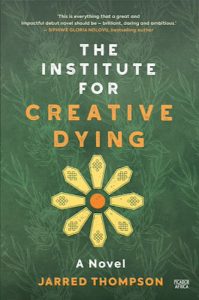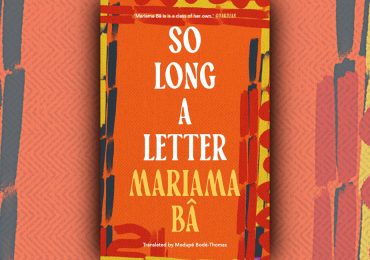The JRB presents an exclusive excerpt from The Institute for Creative Dying, Jarred Thompson’s forthcoming debut novel, which will be published in February 2023.

The Institute for Creative Dying
Jarred Thompson
Picador Africa, 2023
On the slopes of Northcliff, between eight and ten Lancaster Drive, there is an unnumbered house. Joggers, dog walkers, commuters don’t notice the discrepancy because the house can’t be seen from the road and the walls facing the street have been built in seamless face-brick fashion from one numbered house to the next.
To get to the unnumbered house, you must walk up an alleyway that runs between numbers eight and ten. Walking all the way up to the end, on your left there will be a black-lattice gate; you’ll recognise it by the vinca vines that wind up, intertwining with the metal and covering its hinges. Above the gate there are two lanterns—both empty—with layers of wax congealed on their bottoms. If you’ve received an invitation, you will be welcomed by a man with a confident gait. Follow him. He will lead you up a white-and-black-pebbled driveway that curves, at a gradual incline to the left, through verdant, untrammelled gardens.
If you do engage the man, don’t expect much of a response. He enjoys long silences. Rather enjoy the willows and their sleepy, perennially sweeping limbs that line the driveway all the way up to the main house. If you have arrived during summer, brace yourself for the gnats that lilt in wispy communities around the willows. You’ll have to swat your way through the thick of them.
Very soon, a triple-storey roundhouse will come into view, made of arjun, laurel and sheesham wood and topped with a flat-stoned roof, hollowed out in sections for reinforced glass. There are several entrances and exits to the main house. You could enter via the third floor by taking one of the four outdoor staircases that service each storey. It is the kind of roundhouse where a gust of wind might enter through a window on the first floor and exit out the dining room on the third. Speaking of design, the rocks found here on the ridge have been built around, or incorporated into, the structure of the house, so don’t be surprised if a door seems out of place or a window feels skew. The landscape was as much the architect as the owners.
From where you stand now, facing the main house from a worm’s eye view, you won’t see the outside deck of the second and third storey or the aerial walkways that extend into the trees from the third floor. There will be time to explore all of this during your stay. Those who take up an invitation to live here are obliged to take part in the daily maintenance of the property. This, it is felt, is a fair exchange for the free living on offer.
Do not worry. No resident is given more than they can handle on any given day.
I know, it feels like you have walked into the tropics: every curious footstep or misplaced hand revealing insects toiling in precarious worlds all their own. If you’d like, you’re free to wander off the pathway into the curling, webbed gardens, but you do so at your own risk. No, there’s nothing out there that wants to hurt you. Equally, don’t be frightened by the rambunctious dog circling your feet, dashing off through the shrubbery and appearing further up the path on a lichen-covered rock. Abbas shows off for strangers.
Another thing. The ridge is particularly prone to lightning strikes, so when those Joburg thunderstorms come rolling over it’s best to stay indoors. The cooling rains do lessen the humidity, somewhat. Because the ridge is such a hotspot for lightning, you will find the property glazed in fulgurite: vesicular masses of glassy, vitrified soil. Like the ones you see on your right. It is astounding, don’t you think, that such monstrous force can be fossilised (and look gorgeously alien, too).
Keep up now. Don’t let the shimmering sediment distract. Follow the man. You will be asked to wait outside as he prepares your reception. Yes, the path is uneven and not very forgiving on roller bags. Pick up your belongings with core engaged, pelvis tucked, back straight, knees slightly bent. That way you’ll be using your whole self, not just your arms.
~~~
- Jarred Thompson is an educator and literary studies researcher whose poetry, fiction and non-fiction have been published in various journals, notably the Gerald Kraak Anthology Vol 3, Racebait, Lolwe, Doek! and Fiyah. He was the winner the 2020 Afritondo Short Story Award and the runner-up in the 2021 Dream Foundry Short Story Prize. Follow him on Twitter.
~~~
Publisher information
Five strangers—a model, a former nun, a couple in crisis, and an offender newly released from prison— have come here, to this place, to discover an end to life as they’ve known it.
Placing their trust in their hosts, the Mortician and Mustafa, the five open their minds and bodies to an alternative experience. Not all of them will survive—or at least not in the way they imagined—but all of them will be shown the limits of their living.
The Institute for Creative Dying by Jarred Thompson is vivid and visceral, unique in its bold and imaginative exploration of mortality and the interconnectedness of all forms of being.
Out in February 2023.





